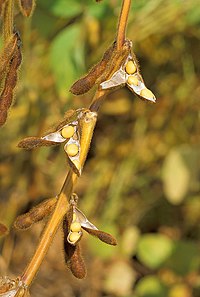
Photo from wikipedia
This study aimed at investigating the effects of genotype and temperatures on the proteolytic activity in green malt of 48 barley genotypes, including 19 mutants, 15 hulled, 4 hulless, and… Click to show full abstract
This study aimed at investigating the effects of genotype and temperatures on the proteolytic activity in green malt of 48 barley genotypes, including 19 mutants, 15 hulled, 4 hulless, and 10 wild using enzyme assays based on casein, as substrate. During malting, insoluble barley protein must be hydrolyzed into soluble peptides and free amino acids to supply the brewing yeast with sufficient nutrients to grow rapidly and metabolize glucose and other sugars into alcohol through fermentation. However, the relatively hot temperatures employed during kilning usually denature the proteolytic enzymes due to their thermolabile nature. Even though the hydrolytic activity of most of the proteases is destroyed during the kilning process, the malt includes a small fraction of thermostable proteases that can further degrade protein in the subsequent mashing process. Considering the higher temperature range employed in industrial kilning and mashing, three temperatures (37, 50, and 70°C) were selected to identify the genotypes possessing high activity at the higher range of temperatures as well as thermostable variant of the enzyme. The proteolytic activity in all the genotypes declined after 50°C depicting its optimum temperature. Overall proteolytic activity was observed to be positively correlated with the amino acids and negatively correlated with protein content. Three mutant (BL2086, BL2091, and BL2079) and one wild (WS 237) genotypes possessing proteolytic activity in a higher range at all the studied temperatures have the potential to be exploited in the breeding programs for incorporating trait of thermostable proteolytic activity into low malting efficiency cultivars. PRACTICAL APPLICATION: The optimal hydrolytic activities of carbohydrases and proteases during mashing are essential for producing high-quality wort from malted barley to ensure that hydrolyzed molecules are available to brewers' yeast to support fermentative metabolism. In this study, several barley cultivars were grown under identical environmental conditions but assayed at different temperatures. As result, four genotypes had been obtained that possessed optimal proteolytic activities at a higher temperature range and can be of great interest to breeders and maltsters for altering wort amino acid profiles and better exposure of starch to mashing enzymes, thereby increasing the fermentable sugar yield from the malt.
Journal Title: Journal of food science
Year Published: 2023
Link to full text (if available)
Share on Social Media: Sign Up to like & get
recommendations!